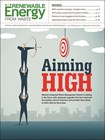From left to right (L-R): Chip Clements of Clements Environmental Corp. acting a moderator for the panel; Michael Silva or CR&R; George Lam of Greenlane Biogas; Jim Miller of J.R. Miller and Associates; and Eberhard Veit of Eisenmann.
The CR&R; Environmental Services (CR&R;) anaerobic digester project team buzzed with excitement over their camaraderie, collaboration and the project itself at the Renewable Energy from Waste Conference in Long Beach, California, on Nov. 16 during the session “California Case Study: CR&R.;”
Michael Silva, organics processing project manager for CR&R; Environmental Services, Perris, California; Eberhard Veit, research and development manager for Eisenmann, with U.S. headquarters in Crystal Lake, Illinois; George Lam, product manager for Greenlane Biogas, Burnaby, British Columbia; and Jim Miller, founder of J.R. Miller and Associates, Brea, California each spoke of his role in the ongoing project.
“This project was very collaborative,” Veit said during the panel. “CR&R; has an excellent team of operators. There’s no bickering about ‘this is yours and this is mine’—we ask what the best approach is to get it done and we work on it.”
CR&R; has 50 municipal hauling contracts, 12 processing contracts and 900 trucks that Silva said will be 100 percent convert to renewable natural gas (RNG) by 2020. The company also owns two landfills and transfer stations. In order to reach its goal of converting its fleet to RNG, the company decided to build a massive anaerobic digester to create the RNG.
The project costs $50 million, Silva said, with the funds coming from several grants. The digester will have the capability to process up to 335,000 tons per year, creating 4 million tons of RNG per year and 250,000 tons of soil products per year.
Eisenmann supplied the anaerobic digestion system to CR&R;, one that Veit called “the largest built so far.” The company installed four parallel digesters at the site that can take solid and liquid waste simultaneously. The continuously run digester features a center auger that will create “as much biological action as possible,” Silva says. After that, the separated solids are sent to composting and the rest is sent to a membrane where it is upgraded to truck fuel or pipeline-quality fuel by Greenlane Biogas’ waterwash hybrid performance system.
“The system was fit to what the customer needed,” Veit said. “CR&R; supplied feedstock that was already prepared and all components of the facility communicated openly.”
Lam said the decision to use the waterwash system was based on what CR&R; called for.
“Selecting the appropriate application depends on biogas composition, how large the facility is and what amount of methane we need to convert,” Lam said.
The waterwash hybrid performance system is compliant with Rule 30 specs, a state guideline created to specify the quality of pipeline gas, creates premium methane recovery and low capital expenditure and operating costs. The system will create 1,200 standard cubic feet per minute of biogas.
The structure surrounding the project will come from J.R. Miller and Associates, who have previously worked to build transfer stations, materials recovery facilities, anaerobic digestion facilities and organics processing facilities.
“It’s a balance of process integration and plant design,” Miller said. “We look at the physical side of wrapping these technologies in a construction project.”
This anaerobic digestion site was developed by CR&R; in the early 90s but has been amended to accommodate the technology updates over time, such as a receiving building that was added to the transfer station where trucks come in, tip its waste onto the floor and is preprocessed to remove contaminants and recyclables. The recyclables go back to the attached transfer station.
“[The receiving floor] is a proprietary process,” Miller said. “The conveyors that take waste to the digesters are another proprietary process.”
At the moment, one digester is running at the CR&R; site. The second is being built and the third and fourth will be construction soon.
Each week, the project team members hold a meeting to update each other on what each company is working on.
“There support from everyone is there,” Veit said. “It’s a team and everyone is putting in their best effort to make it a success.”
The REW Conference is Nov. 14-16 at the Westin Long Beach, in Long Beach. California.


